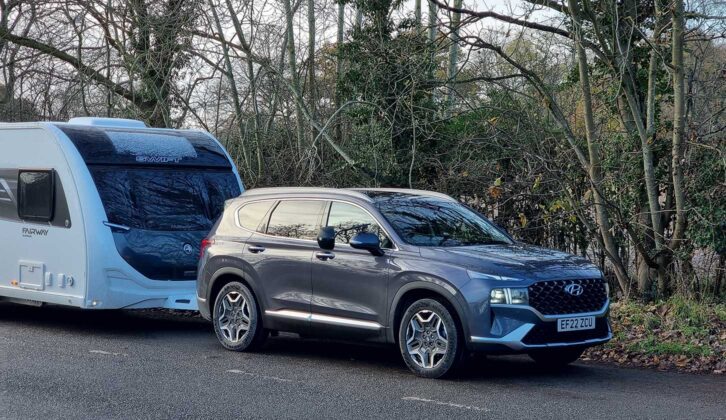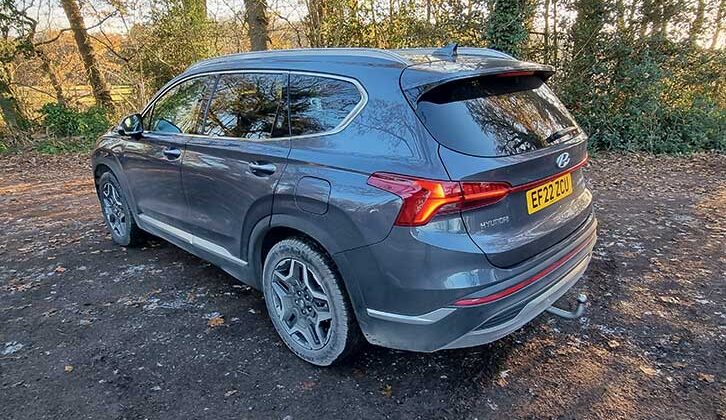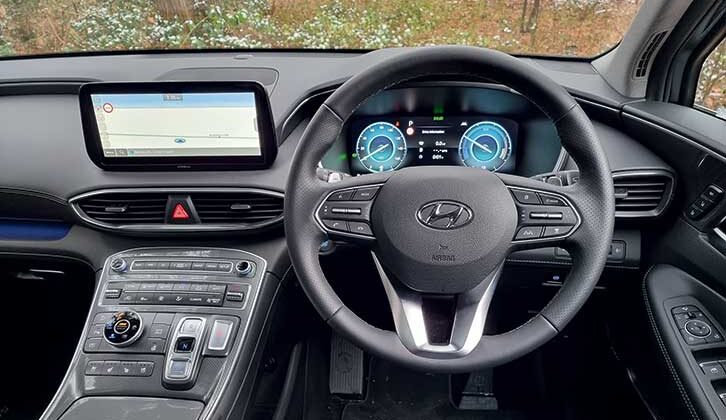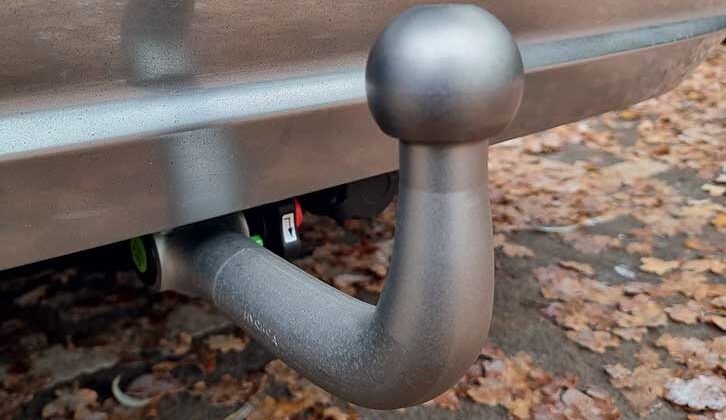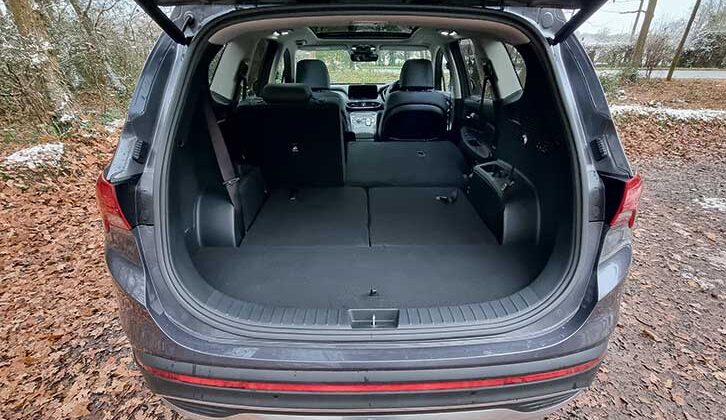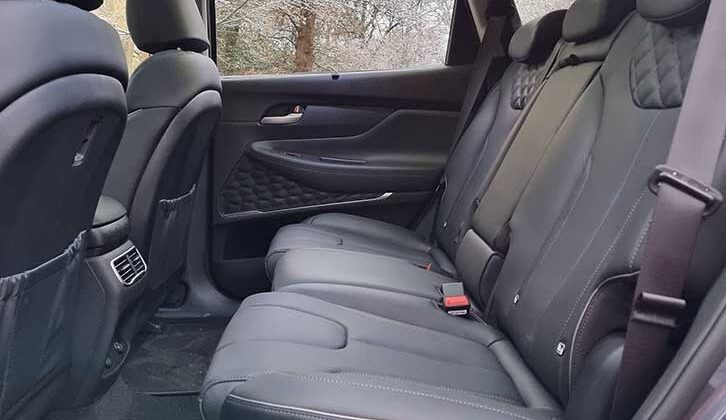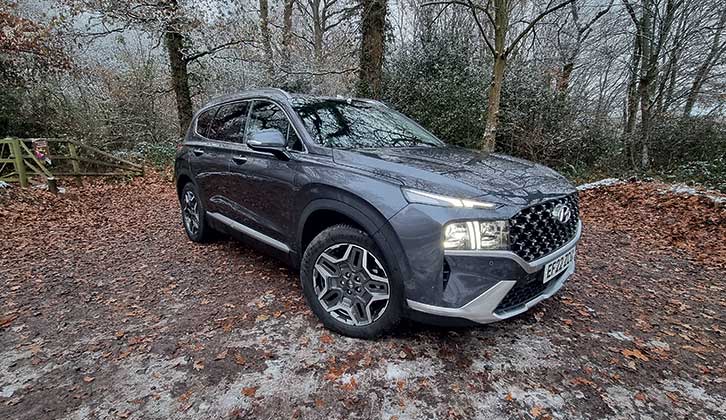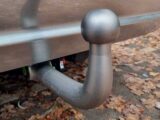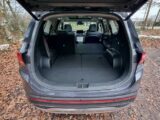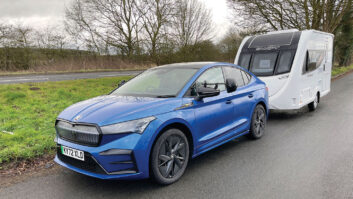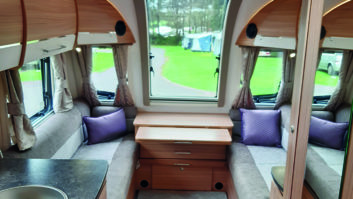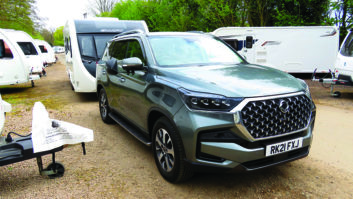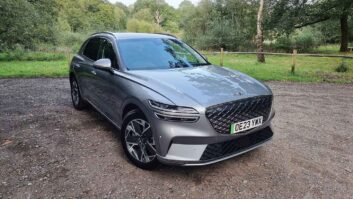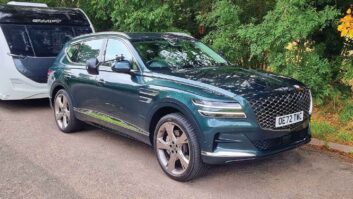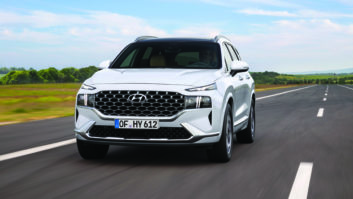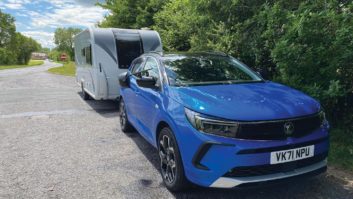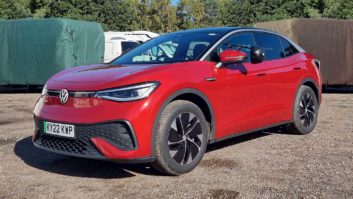Hyundai updated the Santa Fe SUV in 2021, offering new looks, and hybrid and plug-in hybrid powertrains alongside the familiar diesel. The plug-in hybrid tow car is the more powerful of the two new engine options, but the regular hybrid is more affordable to buy and has a higher towing limit. It’s available in both two- and four-wheel-drive guises. We’ve been testing the 4×4 Hyundai Santa Fe 1.6 T-GDi Hybrid Ultimate 4WD Auto. In high-spec Ultimate trim, it costs £47,760.
What are we looking for?
The Santa Fe has been a popular choice for caravanners since 2001, but most examples sold over the past couple of decades have been diesel-powered. How does the hybrid tow car perform, in everyday driving and as a tow car? Should it be caravanners’ first choice?
Towing ability of the Hyundai Santa Fe 1.6 T-GDi Hybrid Ultimate 4WD Auto
Not so long ago, choosing an engine for your Santa Fe was easy – there was just the one, a 2.2-litre diesel. You can still buy a diesel, but more buyers now choose one of the hybrids. The plug-in is the most powerful in the range, with 265hp, but it’s expensive and the towing limit is a modest 1350kg.
Despite having less power, the regular hybrid has a more useful maximum towing figure of 1650kg. Hyundai quotes a range of kerbweights from 1842-1980kg. Working from the lower weight gives an 85% match figure of 1566kg. We matched the Santa Fe to a Swift Fairway Platinum Grande 580 with a MiRO of 1505kg.
Hitching up a caravan was mostly straightforward. The removable towbar quickly locked into place. However, the electrical socket was some way under the back bumper, so we had to reach underneath to twist the plug home. It would be better if the socket were not so far under the car and hard to reach. Fitting towing mirrors was easy, because the housing isn’t heavily curved.
On the road, the Hyundai immediately felt at home with a caravan in tow. With the petrol engine and the electric motor working together, car and van accelerated briskly and we never felt the need for more power. However, there was sometimes a moment of hesitation when pulling away from junctions, when the car relied on the motor before turning to the engine as well.
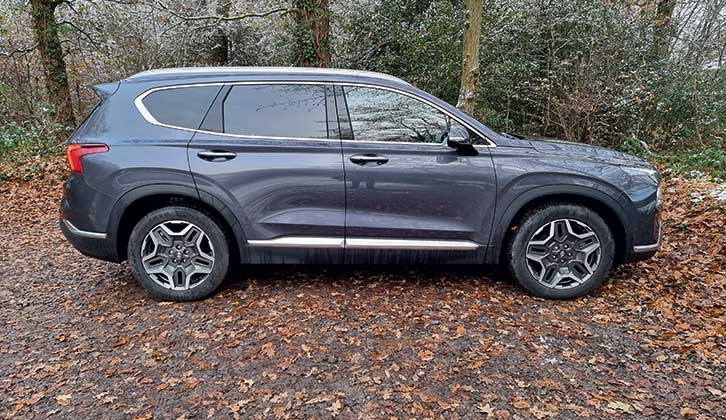
Accelerating hard, the engine can sound a little strained, but once up to speed, it settles into the background. The six-speed gearbox changes gear smoothly, but could be a bit quicker to swap to a lower gear. However, switching from Eco to Smart driving mode does make the gearbox more eager and responsive.
The Santa Fe’s suspension has been tuned for comfort, rather than sporty handling. That doesn’t always make for stability at speed, but we’ve no complaints about its towing composure. The big SUV feels secure and stable at speed, on both single-carriageway roads and motorways.
We could feel slight movements when being overtaken by HGVs, but nothing to cause concern. If the caravan did begin to move in the mirrors, the Hyundai soon pulled it straight again.
We were towing in wintry conditions, with testing taking place in the cold snap towards the end of last year when there were icy roads and patches of snow. Despite this, the Santa Fe had no trouble making a hill start on a 1-in-10 slope. The electronic parking brake held car and van still and released smoothly, and the Hyundai pulled away with no wheelspin or other sign of strain.
For regular towing, we’d certainly pick the 4×4 over the two-wheel-drive model, even with the £2000 price premium.
Solo driving
Even the keenest caravanner will cover more miles in everyday driving than when towing, and the Santa Fe continues to impress without a caravan behind it.
The comfort-first suspension suits tasks like commuting or the school run. You get jostled by sharp bumps, especially at low speeds, but for the most part, the Hyundai does a good job of smoothing over our pockmarked roads.
There’s still enough control for the Santa Fe to feel composed at high speeds and on twisty country roads, but you are aware of its size and weight if you do start to get a move on. It handles neatly enough, and body lean isn’t excessive by SUV standards. But if you are looking for a sporty drive, the big Hyundai probably isn’t for you. Competent? Yes. Exciting? No.
Town driving suits the hybrid powertrain, as plenty of stopping and starting provides lots of opportunity to top up the battery. The Santa Fe will often run on electricity alone at low speeds, although unlike the plug-in hybrid version, it doesn’t have the battery capacity to complete long distances on electricity. Transitions between electric and petrol-electric running are so smooth, you’ll hardly notice.
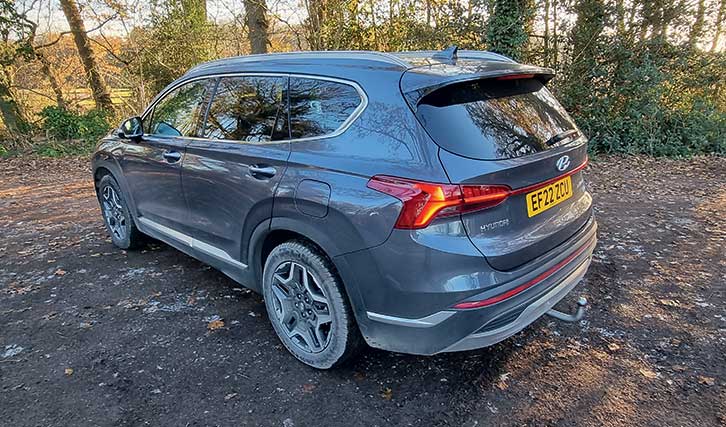
It’s only when you put your foot down that you hear a little too much noise from the petrol engine. At high speeds, there is some wind noise, and the tyres rumble a little over coarse surfaces. Overall, though, the cabin stays quiet enough to be a relaxing place to while away the miles on long journeys.
Space and practicality in the Hyundai Santa Fe 1.6 T-GDi Hybrid Ultimate 4WD Auto
The Santa Fe is one of the most practical SUVs you can buy, with lots of space and features, something people will consider when they’re looking for the best caravan tow car.
The driver and the front-seat passenger have enough room to get comfortable, although really tall drivers might wish for a little more legroom. Both front seats adjust electrically, and there’s also a memory function for the driver’s seat.
A head-up display, which projects the car’s speed and other information, is standard on Ultimate spec. We really appreciate being able to check our speed without taking our eyes from the road, but some find the display distracting. If so, it can be switched off.
The digital dials change their look depending on the driving mode, although the screen can’t be configured to the same extent as the display in an Audi Q5.
There’s a large 10.25-inch touchscreen in the centre of the dash. This is reasonably straightforward to use, and Hyundai has sensibly kept the air-con controls separate.
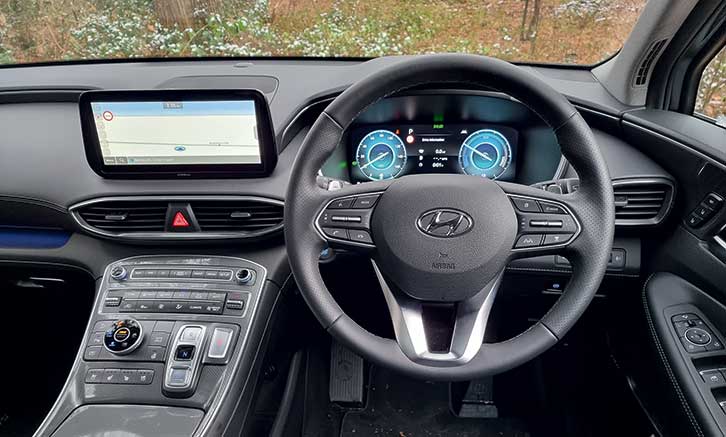
Adult passengers will be very comfortable in the middle row. Thanks to the near-flat floor and the wide cabin, three can travel without feeling cramped. With just two in the middle, there’s plenty of room, and the seats can recline if somebody needs a nap. There are air vents between the front seats to blow chilled air, and USB sockets for charging phones and tablets.
Access to the third row is easy from the nearside, as the outer seat in the middle tilts and slides out of the way at the push of a button. It makes clambering into the back less of a challenge.
The middle row slides back and forth on runners, so these seats can move to give people in the rear a little more space. Children should be fine, while adults will be okay but won’t relish long journeys. Either way, the thick pillars make the third row feel a bit claustrophobic.
With all seats upright, there’s enough space for a few bags of shopping. Fold the third row into the floor and luggage space becomes a lot more generous.
The middle row of seats can also easily be lowered, at the push of a button, to provide plenty of additional load space.
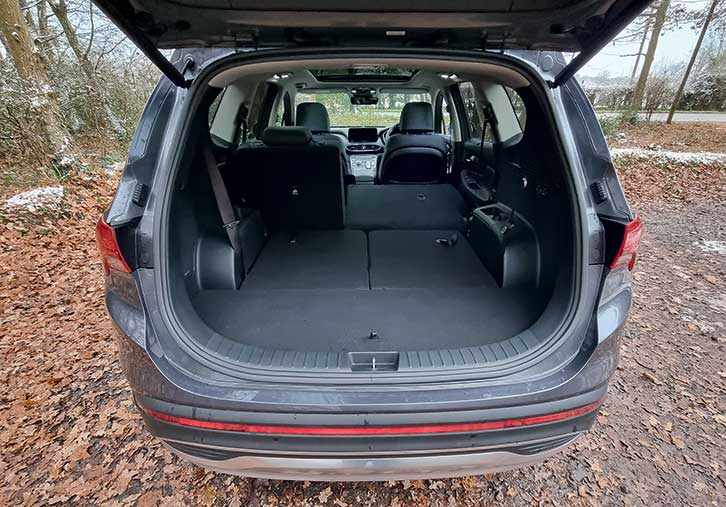
Buying and owning a Hyundai Santa Fe 1.6 T-GDi Hybrid Ultimate 4WD Auto
With an asking price of £47,760, Hyundai is looking for quite a considerable sum of money for the Santa Fe Ultimate.
Compare the price with the brand’s rivals, however, and the Santa Fe is good value. The Kia Sorento Hybrid, to which the Santa Fe is closely related, costs over £3000 more.
Ultimate models come with 19-inch alloy wheels, heated and ventilated front seats, heated outer rear seats, leather seats, dual-zone climate control, and compatibility with Android Auto and Apple CarPlay.
According to What Car?, the Santa Fe should hold on to an impressive 54% of its original price after three years and 36,000 miles.
Fuel bills will be fairly steep, though, even with the option of hybrid power. We saw 33-37mpg in solo driving and just 21.4mpg while towing a caravan.
Verdict on the Hyundai Santa Fe 1.6 T-GDi Hybrid Ultimate 4WD Auto
Until recently, if you had asked us to name the best sensibly priced large SUV, we would have pointed you in the direction of the Kia Sorento. Now, though, we’d pick the Hyundai Santa Fe.
The two vehicles look quite different, but they are mechanically similar. Both are practical and stable seven-seat tow cars, but the Hyundai is much better value. Kia now offers the Sorento in just one very high specification, and we couldn’t justify spending over £3000 more for it.
So if the Santa Fe is now our favourite non-premium 4×4, why four stars rather than five? Well, although the hybrid tows well, we would like to see better than 40mpg in everyday driving and an improvement in the towing economy, too. And it’s a small point, but we’d rather not have a moment’s hesitation in pulling away, even for just half a second. On balance, we still think the 2.2-litre diesel is the pick of the range for towing.
Whichever Santa Fe you choose, this is a stable tow car, with enough performance to handle large vans. Driven solo, it’s easy to live with. The ride is smooth and you breeze through town in quiet and comfort.
Anyone in the first two rows has plenty of space, and those in the third row aren’t as cramped as they’d be in plenty of rivals. With the third row stowed, there’s lots of room for luggage. It really is a very practical car.
Although we’d still pick the diesel, if you choose the hybrid Santa Fe, you won’t be disappointed.
Or you could try:
Kia Sorento Hybrid
- Price: From £50,995
Very similar to the Santa Fe, although the Sorento is more expensive.
Ford Kuga 2.5 PHEV 225PS
- Price: From £37,755
Fewer seats than the Hyundai, but good value to buy and run.
Technical spec:
- Price: £47,760
- What Car? Target Price: £45,052
- Retained value after three years: 54%
- Kerbweight: 1842kg
- 85% of kerbweight: 1566kg
- Gross vehicle weight: 2630kg
- Max towing limit: 1650kg
- Gross train weight: 4280kg
- Towball limit: 100kg
- Price of towball and electrics: Dealer-fit accessories
- Boot size min/max: 571/1649 litres
- Payload: 788kg
- Test conditions: Damp
- Engine size: 1598cc
- Official combined economy: 38.2mpg
- Towing economy: 21.4mpg
- Power (hp)/rpm: 230/5500*
- Torque (lb ft)/rpm: 196/1500-4500
- CO2 emissions: 168g/km
- First year car tax: £575
- Second year car tax :£510
- Insurance group: 24E
- Euro NCAP overall protection rating: 5/5
*Engine and motor combined
If you’ve enjoyed reading this article, why not get the latest news, reviews and features delivered direct to your door or inbox every month. Take advantage of our brilliant Practical Caravan magazine SUBSCRIBERS’ OFFER and SIGN UP TO OUR NEWSLETTER for regular weekly updates on all things caravan related.
Technical Specifications
| Engine Size | 1598 cc |
| Kerbweight | 1842 kg |
| 85% KW | 1566 kg |
| Towball Limit | 100 kg |
| Maximum Towing Limit | 1650 kg |
| Power | 230 bhp |
| Torque | 196 lb ft |
| Offical MPG | 38.2 mpg |
| Towing MPG | 21.4 mpg |
| CO₂ | 168 g/km |
